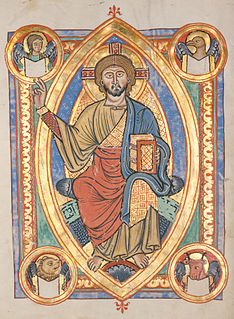 W
WThe Stations of the Cross or the Way of the Cross, also known as the Way of Sorrows or the Via Crucis, refers to a series of images depicting Jesus Christ on the day of his crucifixion and accompanying prayers. The stations grew out of imitations of the Via Dolorosa in Jerusalem, which is a traditional processional route symbolising the actual path Jesus walked to Mount Calvary. The objective of the stations is to help the Christian faithful to make a spiritual pilgrimage through contemplation of the Passion of Christ. It has become one of the most popular devotions and the stations can be found in many Western Christian churches, including Anglican, Lutheran, Methodist, and Roman Catholic.
 W
WThe burial of Jesus refers to the burial of the body of Jesus after crucifixion, before the eve of the sabbath described in the New Testament. According to the canonical gospel accounts, he was placed in a tomb by a councillor of the sanhedrin named Joseph of Arimathea,. In art, it is often called the Entombment of Christ.
 W
WA calvary, also called calvary hill, Sacred Mount, or Sacred Mountain, is a type of Christian sacred place, built on the slopes of a hill, composed by a set of chapels, usually laid out in the form of a pilgrims' way. It is intended to represent the passion of Jesus Christ and its name after the Calvary, the hill in Jerusalem where, according to tradition, Jesus was crucified.
 W
WChrist Carrying the Cross on his way to his crucifixion is an episode included in all four Gospels, and a very common subject in art, especially in the fourteen Stations of the Cross, sets of which are now found in almost all Catholic churches. However, the subject occurs in many other contexts, including single works and cycles of the Life of Christ or the Passion of Christ. Alternative names include the Procession to Calvary, Road to Calvary and Way to Calvary, Calvary or Golgotha being the site of the crucifixion outside Jerusalem. The actual route taken is defined by tradition as the Via Dolorosa in Jerusalem, although the specific path of this route has varied over the centuries and continues to be the subject of debate.
 W
WThe crucifixion of Jesus occurred in 1st-century Judea, most likely in either AD 30 or AD 33. Jesus' crucifixion is described in the four canonical gospels, referred to in the New Testament epistles, attested to by other ancient sources, and is considered an established historical event by many, although there is no consensus among historians on the exact details.
 W
WThe Descent from the Cross, or Deposition of Christ, is the scene, as depicted in art, from the Gospels' accounts of Joseph of Arimathea and Nicodemus taking Christ down from the cross after his crucifixion. In Byzantine art the topic became popular in the 9th century, and in the West from the 10th century. The Descent from the Cross is the 13th Station of the Cross, and is also the sixth of the Seven Sorrows of the Blessed Virgin Mary.
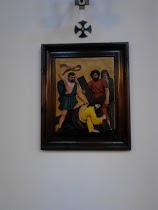 W
WJesus falls the first time is the third Station of the Cross that is displayed in most Catholic Churches.
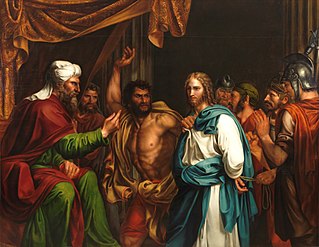 W
WIn the New Testament, the Sanhedrin trial of Jesus refers to the trial of Jesus before the Sanhedrin following his arrest in Jerusalem and prior to the trial before Pontius Pilate. It is an incident reported by all three Synoptic Gospels of the New Testament, while John's Gospel refers to a preliminary inquiry before Annas. The gospel accounts vary on a number of details.
 W
WThe Lamentation of Christ is a very common subject in Christian art from the High Middle Ages to the Baroque. After Jesus was crucified, his body was removed from the cross and his friends mourned over his body. This event has been depicted by many different artists.
 W
WMiren Castle is an elevation above the settlement of Miren near Nova Gorica, in southwest Slovenia. Its Slovene name reflects the fact that the hill was once occupied by a castle; it is currently dominated by a collection of ecclesiastical buildings.
 W
WIn the New Testament, the Sanhedrin trial of Jesus refers to the trial of Jesus before the Sanhedrin following his arrest in Jerusalem and prior to the trial before Pontius Pilate. It is an incident reported by all three Synoptic Gospels of the New Testament, while John's Gospel refers to a preliminary inquiry before Annas. The gospel accounts vary on a number of details.
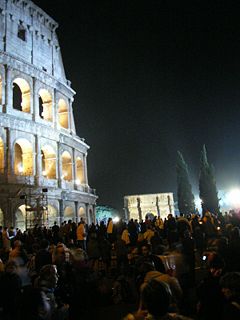 W
WThe Scriptural Way of the Cross or Scriptural Stations of the Cross is a modern version of the ancient Christian, especially Catholic, devotion called the Stations of the Cross. This version was inaugurated on Good Friday 1991 by Pope John Paul II. The Scriptural version was not intended to invalidate the traditional version. Rather it was meant to add nuance to an understanding of the Passion.
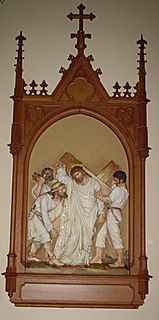 W
WSimon of Cyrene was the man compelled by the Romans to carry the cross of Jesus of Nazareth as Jesus was taken to his crucifixion, according to all three Synoptic Gospels:And as they came out, they found a man of Cyrene, Simon by name: him they compelled to bear his cross.
 W
WSaint Veronica, also known as Berenike, was a woman from Jerusalem who lived in the 1st century AD, according to extra-biblical Christian sacred tradition. A celebrated saint in many pious Christian countries, the 17th-century Acta Sanctorum published by the Bollandists listed her feast under July 12, but the German Jesuit scholar Joseph Braun cited her commemoration in Festi Marianni on 13 January.
 W
WThe Via Dolorosa is a processional route in the Old City of Jerusalem. It represents the path that Jesus would have taken, forced by the Roman soldiers, on the way to his crucifixion. The winding route from the former Antonia Fortress to the Church of the Holy Sepulchre — a distance of about 600 metres — is a celebrated place of Christian pilgrimage. The current route has been established since the 18th century, replacing various earlier versions. It is today marked by nine Stations of the Cross; there have been fourteen stations since the late 15th century, with the remaining five stations being inside the Church of the Holy Sepulchre.